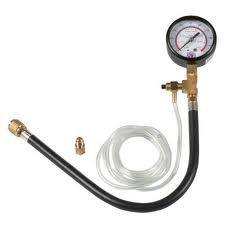Fuel Delivery Problems
A lack of spark is not the only thing that can cause a performance issue. Fuel delivery is equally important. Fuel and air are your engine’s sustenance. Fuel combines with oxygen to create combustion. Not enough fuel, or too much fuel, can upset this process and cause performance issues. All fuel-injected engines are dependent on their fuel pressure. Sometimes a difference of just two or three PSI can cause an engine to run poorly or not at all. If you suspect a fuel problem, the first step is to check the fuel pressure itself. To do this, you’ll need to get your hands on a fuel pressure tester.
Getting your hands on a gauge is just the first step; hooking it up to your engine can be where it gets interesting. There are more hookups to different engines than I can count, so be sure you have the proper adapters for your vehicle so you can hook the gauge up. If you can’t hook the fuel pressure gauge up to your fuel system, you’re wasting your time.
The next step is to know what the pressure is actually supposed to be when you check it. This information can be found in the service manual, but I’ve also seen books that come with some fuel pressure test kits that provide this information.

Now that you’ve hooked up your gauge and have the proper adapter and pressure specs, what next? There are a couple of readings that can give you a good idea of how the fuel delivery system is operating. The first is just a general fuel pressure test while the engine is running. Start the engine, observe the reading, and compare it to your spec. It’s okay if it’s off a couple of pounds; in fact, this is normal. I know I said that some systems are sensitive enough to have performance issues at just a three PSI drop, but in my experience it’s rare to get the exact number I’m looking for when taking a fuel pressure reading. This might be due to how the gauge calibrated. If it’s low, try pinching off the return line to the tank for a few seconds and see what the reading is. If it spikes, this is a good sign and shows that the system is capable of producing more pressure if it needs to. If you don’t see a spike in pressure, your fuel pump might not be capable of putting out enough volume and you might have found the source of your performance problem.
Video Title: Fuel Delivery Problems – Solving Automotive Performance Issues – EricTheCarGuy Video Description: In this Article, Fuel Delivery Problems, we look at how this can impact Engine Performance. Thumbnail: http://www.ericthecarguy.com/images/faq_buttons/Large_FAQ_Images/Performance-and-Driveability-icon-1200.jpg
 Our Address
Our Address




1 thought on “Fuel Delivery Problems”
Tim Deal
August 1, 2021 at 1:34 pm
Hi Eric I removed a holly sniper Efi system back to a carb but have a high pressure fuel pump with a regulator filter bypass in line so one line only goes to the carb I know I will need a regulator to get to 6 or 7 psi do I need to install a return back to the tank or will the regulator bypass work Thanks Tim